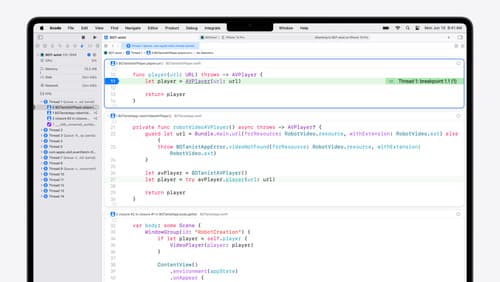how to use GCD and what's under the hood
Asked on 2024-08-05
1 search
To understand how to use Grand Central Dispatch (GCD) and what's under the hood, you can refer to several sessions from WWDC that discuss concurrency and performance in Swift.
-
Explore Swift performance:
- This session provides a deep dive into the low-level performance of Swift, including memory allocation and function calls, which are crucial for understanding how GCD works under the hood. You can start with the introduction and move to the sections on function calls and memory allocation.
-
Migrate your app to Swift 6:
- This session discusses the hidden complexity of concurrency and how Swift concurrency can simplify the architecture compared to using GCD. It explains the transition from ad hoc concurrency with GCD to structured concurrency with Swift. You can start with the section on adopting concurrency features.
-
Discover Swift enhancements in the Vision framework:
- This session includes a segment on optimizing Vision APIs with Swift concurrency, which can provide insights into how concurrency is managed in Swift and how it can be applied to tasks that might traditionally use GCD. Check out the section on optimizing with Swift concurrency.
-
What’s new in Xcode 16:
- This session introduces new tools in Xcode for debugging and analyzing performance, which can be useful for understanding and optimizing GCD usage. The flame graph feature, for example, can help visualize where your code spends the most time, which is crucial for performance tuning.
By exploring these sessions, you can gain a comprehensive understanding of how GCD works and how to effectively use it in your Swift applications.

What’s new in Xcode 16
Discover the latest productivity and performance improvements in Xcode 16. Learn about enhancements to code completion, diagnostics, and Xcode Previews. Find out more about updates in builds and explore improvements in debugging and Instruments.

Explore Swift performance
Discover how Swift balances abstraction and performance. Learn what elements of performance to consider and how the Swift optimizer affects them. Explore the different features of Swift and how they’re implemented to further understand the tradeoffs available that can impact performance.

Analyze heap memory
Dive into the basis for your app’s dynamic memory: the heap! Explore how to use Instruments and Xcode to measure, analyze, and fix common heap issues. We’ll also cover some techniques and best practices for diagnosing transient growth, persistent growth, and leaks in your app.
